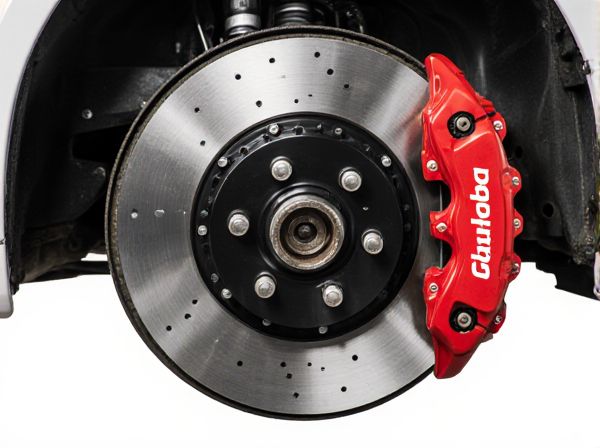
Photo illustration: Monoblock Caliper vs Two-Piece Caliper
Monoblock calipers offer increased rigidity and better heat dissipation due to their single-piece construction, enhancing braking performance and durability. Two-piece calipers provide easier maintenance and customization options, as the separate components can be replaced or upgraded individually. Choosing between them depends on your priorities for performance, maintenance convenience, and budget.
Table of Comparison
| Feature | Monoblock Caliper | Two-Piece Caliper |
|---|---|---|
| Construction | Single solid piece | Two separate components bolted together |
| Weight | Lighter due to integrated design | Generally heavier due to joint hardware |
| Rigidity | Higher rigidity and less flex | Moderate rigidity with potential flex at the joint |
| Manufacturing Cost | Higher cost due to complex machining | Lower cost with easier manufacturing |
| Maintenance | Less serviceable, entire caliper often replaced | Easier to service individual parts |
| Performance | Improved braking performance with consistent pressure | Good performance but potential pressure loss over time |
| Common Use | Sports cars, high-performance vehicles | Standard passenger vehicles, budget applications |
Introduction to Brake Calipers
Brake calipers are essential components in a vehicle's disc braking system, responsible for squeezing brake pads against the rotor to slow or stop the vehicle. Monoblock calipers are machined from a single piece of metal, offering enhanced rigidity and improved braking performance due to reduced flex under pressure. Two-piece calipers consist of separate halves bolted together, providing easier maintenance and cost efficiency, but typically exhibit slightly less stiffness compared to monoblock designs.
What is a Monoblock Caliper?
A monoblock caliper is a single-piece brake caliper made from a solid block of aluminum or steel, designed to offer superior rigidity and improved braking performance compared to two-piece calipers. By eliminating welds or bolts, monoblock calipers reduce flex under high pressure, enhancing pedal feel and consistency in racing and high-performance vehicles. Their lightweight construction and precise machining contribute to better heat dissipation and overall brake system efficiency.
What is a Two-Piece Caliper?
A two-piece caliper consists of separate components: a caliper body and sliding pins, which are bolted together during assembly. This design enhances flexibility and ease of maintenance by allowing individual parts to be replaced or serviced independently. Two-piece calipers are commonly used in automotive braking systems to balance performance and cost-effectiveness.
Design Differences: Monoblock vs Two-Piece
Monoblock calipers are crafted from a single block of aluminum, offering increased rigidity and reduced flex under heavy braking, which enhances braking precision and performance. Two-piece calipers consist of an aluminum body with a separate steel or aluminum bridge bolted together, allowing for easier maintenance and customization but potentially less stiffness compared to monoblock designs. The integrated construction of monoblock calipers typically results in better heat dissipation and weight savings, while two-piece calipers provide modularity benefits for motorsport and tuning applications.
Performance Comparison
Monoblock calipers offer enhanced rigidity and reduced flex due to their single-piece construction, resulting in more consistent braking performance and improved pedal feel under high-stress conditions. Two-piece calipers, typically composed of an aluminum body and steel mounting bracket, provide easier maintenance and cost-effective replacement but may exhibit slight flex during intense braking, potentially impacting stopping precision. Performance-focused applications often favor monoblock calipers for superior heat dissipation and structural integrity, crucial in motorsports and heavy-duty scenarios.
Durability and Strength
Monoblock calipers exhibit superior durability and strength due to their single-piece construction, which eliminates weak points caused by joints or bolts. Two-piece calipers, while easier to manufacture and maintain, often have lower structural integrity and are more susceptible to flexing under high-stress braking conditions. High-performance vehicles typically favor monoblock calipers for enhanced rigidity and consistent braking performance.
Weight and Heat Dissipation
Monoblock calipers, machined from a single piece of aluminum, offer reduced weight and enhanced structural rigidity compared to two-piece calipers, contributing to improved vehicle performance and handling. Their design promotes superior heat dissipation by minimizing thermal distortion and providing efficient heat transfer during braking, which is critical for high-performance applications. Two-piece calipers, while easier to manufacture and service, tend to be heavier and less effective at dissipating heat due to increased joint interfaces and material differences.
Maintenance and Repair Considerations
Monoblock calipers offer easier maintenance due to their single-piece construction, reducing the risk of leaks and simplifying cleaning and inspection processes. Two-piece calipers require more frequent attention to bolt torque and joint integrity, increasing repair time and potential costs associated with gasket or seal replacements. Choosing between the two involves balancing long-term maintenance efficiency against initial assembly complexity and parts availability.
Cost and Value Analysis
Monoblock calipers typically offer higher stiffness and lighter weight due to their one-piece construction, which enhances braking performance but comes at a higher manufacturing cost. Two-piece calipers, designed with separate components joined together, provide a more cost-effective solution while maintaining reliable braking power suitable for standard applications. Evaluating cost and value, monoblock calipers deliver superior performance benefits for high-end or racing vehicles, whereas two-piece calipers provide better affordability and ease of maintenance for everyday use.
Choosing the Right Caliper for Your Needs
Monoblock calipers offer superior rigidity and performance due to their single-piece construction, making them ideal for high-performance and racing applications where brake efficiency and heat dissipation are critical. Two-piece calipers provide greater flexibility and ease of repair, allowing for customization and cost-effective maintenance, which suits everyday driving and budget-conscious users. Choosing the right caliper depends on evaluating your driving style, vehicle type, and maintenance preferences to balance performance with practicality.
 caratoz.com
caratoz.com